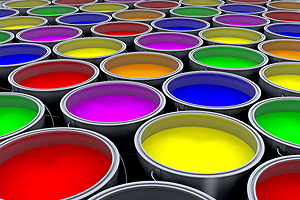Composition and function of coatings

Every kind of coating consists of four kinds of ingredients, namely (1) resin, (2) pigment, (3) solvent, and (4) additives. Among them, the solvent is a kind of volatile organic compound.
(1) Resin
Resin, namely the membrane-forming matter, is the principal component and base of coating, also called base material, and the vital factor determining the property of the membrane. It is required that being a membrane forming matter, the resin should be very stable without any obvious physical change or chemical change in the storage period of the coating. Under the specified condition, it can be quickly dried and congealed into a membrane within the period of membrane formation. There is a great variety of resin products, among which the commonly used ones in the coil coating consist of acrylic resin, epoxy, polyester resin, polyurethane, etc. Different resin has different physical & chemical characteristics as well as different properties in weatherproof, and corrosion resistance.
(2) Pigment
Pigment must match resin in the coating, which mainly colors the membrane. Different proportion of pigment of the coating membrane has different rigidity, glossiness, and corrosion resistance, etc.
(3) Solvent
The solvent is an important component of liquid coating, which is volatile while baking the coating. Generally, the solvent is also used to adjust the viscosity of the coating, and the solvent of this kind is also called diluent. The solvent has important influences on the production, storage and application of coating, the formation of the membrane and the quality of the membrane formation.
(4) Additives
The accessory ingredient is a small amount of additive for improving the performance of the coating. Although the dosage of the accessory ingredient is little in the coating, its function is remarkable. For instance, some of them can improve the performance of coating and that of the membrane, some
can adjust the baking time, and some can prevent the membrane from morbidity. There is a great variety of accessory ingredients, including siccative, curing agent, leveling agent, defoaming agent, flatting agent, stabilizing agent, etc.

Category and film thickness of primers
The category of the primer includes epoxy, polyester, acrylic acid, polyurethane, etc. In general, the primer is chosen in accordance with the usage, environment condition, processing stage and finish coat. The film thickness of the primer is usually 5~7 um.
(1) Epoxy primer
The epoxy primer has strong adhesion to the base metal and good properties in waterproof, alkali-proof and chemical resistance, which is the original primer for the coiled steel, having poorer flexibility than that of other primers.
(2) Polyester primer
The primer has strong adhesion to the base metal and excellent flexibility, which is relatively sensitive to the damp environment and has a chemical resistance poorer than that of epoxy primer.
(3) Water-soluble acrylic acid primer
The primer of this kind has strong adhesion, excellent flexibility, lower organic solvent, and low-temperature curing.
(4) Polyurethane primer
The primer of this kind has excellent chemical resistance, durability, and flexibility.
Category of finish coats
Among all the ingredients of coil coatings, resin and pigment have the function of duration, and the primers commonly used consist of polyester, silicon modified polyester, polyvinylidene fluoride, high durability polyurethane, etc.
(1) Polyester
The finish coat of this kind has strong adhesive force, a variety of colors, wide scope of properties in formation and durability outdoors, moderate chemical resistance and low cost.
(2) Silicon modified polyesters
The membrane of the finish coat of this kind has excellent rigidity, abrasion resistance, thermal resistance, good outside durability, chalking resistance, high retention of color and luster, ordinary flexibility, moderate cost, etc.
(3) High-durability polyester
The finish coat of this kind has excellent retention of color, the resistance of ultra-violet radiation, strong outdoors durability, chalking resistance, strong adhesion to the base metal, plenty of colors and relatively lower cost compared to the same quality.
(4) Polyvinylidene fluoride
The finish coat of this kind features in its excellent retention of color, the resistance of ultra-violet radiation, outdoor durability, chalking resistance, resistance to solvent, formability, good dirt resistance, finite colors, and high cost.
Polyvinylidene fluoride
Usage of fluorocarbon prepainted sheet
The PVDF fluorocarbon coating is a masterwork among the existing construction coatings, which is generally acknowledged as an organic coating with the best protective performance, guarantees the metal building board not to be damaged for decades and always retains its beautiful color. Since entering the market in 1965, the fluorocarbon coatings world-widely
applied to buildings have already successfully traveled through various poor weathers and still remained perfect in the past 30 years. PVDF denotes polyvinylidene fluoride. The fluorine carbon bond formed by a fluorine atom with the largest electronegativity, together with its unique symmetry of the molecule, lets the PVDF has extra stability, unique resistance to
photolysis of ultra-violate radiation, excellent insulation, and mechanical properties.
Performance of coating
The coating adopts some patented recipes, Kynar 500 or Kynar 5000, and inorganic ceramic pigment, and each kind of new materials must be put into commercial uses upon Florida’s ten-year insolation certificate, which guarantees the product quality. The prepainted steel sheet for the workshop of Fitzpatrick Nuclear Power Plant of the U.S.A. adopts the hot-dip zinc-coated base metal that is coated with the fluorocarbon coating with 70% resin content. Since the workshop was built in 1971, while not only the surface and the base metal of the prepainted steel sheet is still perfect, but also its color is retained well.

